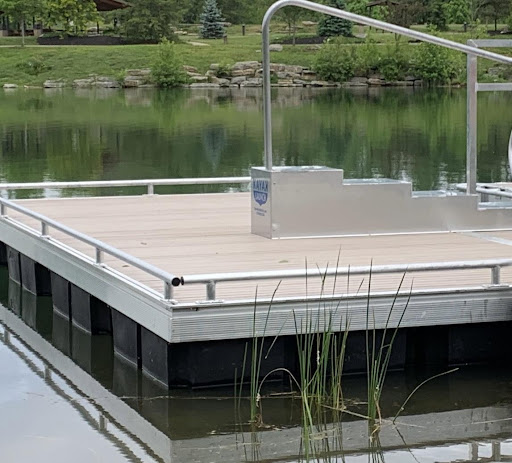
Unless you’re part of the boating industry, “freeboard” is a term not commonly used in everyday language. More than likely, most people would not be able to define what freeboard means or explain its meaning to others.
Although similar, but completely unrelated, freeboard is not to be confused with “Free Bird,” the famous song released by the rock band Lynyrd Skynyrd in 1973. Most people probably have at least some familiarity with the lyrics of this song.
Now, getting back to the topic of freeboard, “freeboard” is the distance from the top of a floating dock to the top of the water. For those who like to boat, kayak, or row, freeboard will have an impact on your ability to enter and exit your vessel with ease and will determine how much a floating dock stands out above the water. The picture shown below is a visual representation of the freeboard and will help you understand its meaning. Freeboard is measured from the top of the rowing dock down to the top of the water.

The freeboard of a typical rowing dock is 6 inches. As shown here, rowing docks sit relatively close to the water level.

For a floating dock, the freeboard will remain a consistent dimension. It will not fluctuate unless excessive live loads are put onto the dock. A visual representation of a floating dock’s freeboard can be seen in the picture below. Freeboard is measured from the top of the dock’s aluminum frame down to the top of the water. A standard floating dock sits higher above the water than a rowing dock.

For fixed piers that do not move up or down, the freeboard dimension may change or vary any time there’s a tidal fluctuation, a drought, or any type of flooding condition. In this case, the dock is held to a fixed location and the water level is what moves up or down.
Why are certain systems designed for a specific freeboard (ex: 16”)?
Freeboard may be dictated by a customer’s specific design requirements. For example, in a marina application, the size of the vessels being moored at the dock may dictate the dimension of the freeboard. Smaller boats may require a smaller and lower freeboard whereas larger boats may dictate a larger and higher freeboard. The dock design and purpose of the dock typically call for a specific freeboard.
Why do you need to know your freeboard when building a dock?
When a new dock is being manufactured and built to connect to an existing dock or pier, the freeboards must be the same in order for the connecting docks and piers to be level with each other when floating on the water.
Is there a standard freeboard for rowing docks compared to boat docks, kayak launches, and fishing piers?
The freeboard for a rowing dock is normally 6 inches. The reason behind this is and the reason rowing docks float closer to the water is to allow for the crew members to enter their vessel at a level closer to the height of the floating dock and use their oars to hold the boat in place when boarding their sculls.
Boat dock, fishing pier, kayak, and canoe launch freeboards are normally 16 inches but can be adjusted to 15 – 18 inches due to the size and number of flotations attached to the bottom of the dock. These dock systems typically sit higher above the water.
What’s the easiest way for me to measure the freeboard of my dock?
The easiest way to measure your dock’s freeboard is to use a straightedge at the top of the dock and measure down to the top of the water. In order to get the most accurate measurement, the measurement should be taken several times and averaged. This will provide you with the most accurate freeboard measurement. Be careful not to put weight on the point which would affect your measurement.
How will my gangway affect my dock’s freeboard?
The weight of your dock’s gangway will affect your dock’s freeboard. Additional flotation will need to be put on the end of the dock where the gangway lands to help keep the dock level. Another solution would be to hinge the gangway to the dock and put additional separate flotation under the gangway.
BoardSafe Docks manufactures high-quality commercial-grade floating docks, rowing docks, kayak launches, fixed piers, and gangways. The aluminum welded frames are a product whose quality stands out from others due to their versatility and ability to withstand the test of time and elements of weather.
For more information on products offered by BoardSafe Docks — customized aluminum floating docks and other adaptive kayak launch innovations — or to schedule a design consultation, visit BoardSafeDocks.com or call (610) 899-0286.
